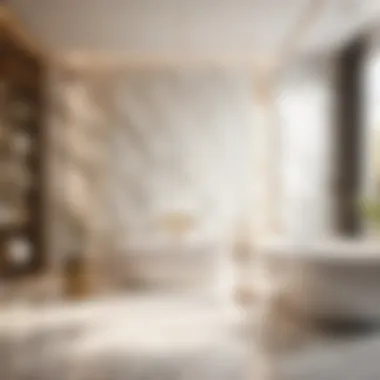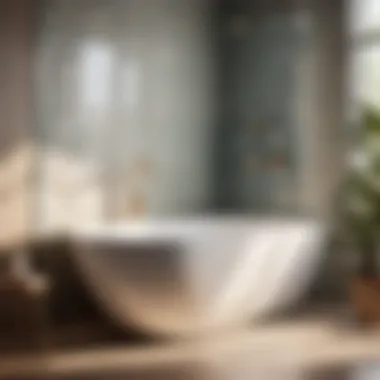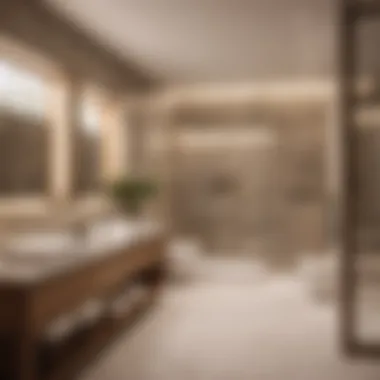Unveiling the Comprehensive Breakdown of Bathroom Construction Costs


Materials:
- Marble tiles: 100 sq. ft
- Porcelain sink: 1 unit
- Shower fixtures: 1 set
- Toilet bowl: 1 unit
- Plumbing pipes: as needed
DIY Steps:
- Design layout of the bathroom according to available space and personal preferences.
- Calculate required materials by measuring the area for tiling and fixtures.
- Purchase materials ensuring correct measurements for precise installation.
- Prepare the bathroom space by clearing out existing fixtures and ensuring plumbing connections are in place.
Technical Aspects:
- Tools needed: Tile cutter, wrench, screwdriver, level, pipe cutter, measuring tape
- Timing specifics: Allocate 2-3 weeks for complete bathroom construction
- Critical techniques: Proper waterproofing for durability, precise measurement for seamless fitting
DIY Project Process:
- Start by tiling the floor, followed by walls using the chosen marble tiles.
- Install the porcelain sink and shower fixtures securely, ensuring proper sealing for no leaks.
- Fix the toilet bowl in place and connect plumbing pipes for functionality.
Troubleshooting Tips:
- Leaking fixtures: Reapply sealant and tighten connections.
- Uneven tiles: Adjust with a level and reposition for a smooth finish.
Factors Impacting Bathroom Construction Costs
When embarking on a bathroom construction project, it is crucial to consider the multitude of factors that can impact costs. Understanding these factors is essential for effective budgeting and planning. Materials, labor, and permit fees all play significant roles in determining the overall expense of building a bathroom. By delving into the specifics of each aspect, homeowners can make informed decisions to ensure their project stays within budget and meets their expectations.
Materials Costs
In any bathroom construction project, materials represent a substantial portion of the total expenses. From flooring to cabinets, the quality and types of materials chosen greatly influence the overall cost. Each material choice comes with its unique characteristics, advantages, and disadvantages, affecting both aesthetics and budget. By carefully selecting materials based on durability, style, and cost-effectiveness, homeowners can achieve a balance between quality and affordability.
Flooring
Flooring is a fundamental element of bathroom design, serving both functional and aesthetic purposes. Choices such as tile, vinyl, or natural stone impact not only the look of the space but also its maintenance requirements and longevity. When considering flooring options, factors such as water resistance, slip resistance, and ease of cleaning should be taken into account. By opting for durable and aesthetically pleasing flooring materials, homeowners can enhance the appearance and functionality of their bathroom while ensuring long-term value.
Tiles and Backsplash
Tiles and backsplashes add texture and visual interest to bathroom spaces. Whether selecting traditional ceramic tiles, modern glass mosaics, or luxurious marble finishes, the choice of tiles directly affects the overall aesthetic appeal. Additionally, backsplashes protect walls from water damage and simplify cleaning and maintenance. By choosing high-quality tiles that complement the design theme, homeowners can create a cohesive and stylish bathroom environment.
Fixtures (Sink, Toilet, Shower, Tub)
Fixtures such as sinks, toilets, showers, and tubs are essential components of any bathroom. The quality, style, and features of these fixtures vary widely, catering to different needs and preferences. Factors such as water efficiency, ease of cleaning, and durability influence the selection of fixtures. By investing in fixtures that are not only functional and stylish but also cost-effective in terms of water usage and maintenance, homeowners can optimize both comfort and sustainability in their bathroom design.
Countertops


Countertops serve as both practical work surfaces and decorative elements in bathrooms. Choices like granite, quartz, or laminate offer varying levels of durability, visual appeal, and maintenance requirements. Selecting countertops that are resistant to moisture, heat, and stains ensures long-term functionality and aesthetics. By harmonizing countertop materials with the overall design scheme, homeowners can elevate the luxury and functionality of their bathroom space.
Cabinets
Cabinets contribute significantly to the storage and organization of bathroom essentials. From sleek modern designs to timeless classics, cabinet styles can enhance the overall ambiance of the space. Factors such as material quality, storage capacity, and ease of maintenance are essential considerations when choosing cabinets. By opting for well-crafted cabinets that offer both functionality and style, homeowners can optimize space utilization and enhance the overall appeal of their bathroom.
Cost Breakdown of Building a Bathroom
In the realm of bathroom construction costs, the Cost Breakdown holds significant weight as it provides a detailed analysis of where the expenses lie within the entire project. By dissecting the Average Costs into Low-End, Mid-Range, and High-End categories, homeowners gain invaluable insights into the financial spectrum of building a bathroom. Understanding these cost breakdowns is essential for effective budgeting and decision-making throughout the construction process.
Average Costs
Low-End:
The Low-End segment of bathroom construction encompasses budget-friendly options that cater to those seeking a cost-effective approach. This budget tier generally includes basic materials and fixtures, minimal frills, and straightforward designs. While Low-End choices are economical, they may lack some of the luxurious features found in higher-end options. Homeowners opting for the Low-End cost range can benefit from savings on upfront expenses, making it a practical choice for those on a tight budget.
Mid-Range:
Moving up the scale, the Mid-Range category offers a balance between affordability and quality. Mid-Range bathroom construction typically involves mid-level materials, slightly enhanced fixtures, and moderate design intricacies. This category appeals to individuals looking for a mix of value and aesthetics without overspending. While Mid-Range options may not match the extravagance of High-End choices, they provide a solid middle ground for those seeking durability and style within a reasonable budget.
High-End:
At the top end of the cost spectrum, the High-End segment presents luxurious and high-quality options for discerning homeowners. High-End bathroom construction involves premium materials, top-of-the-line fixtures, intricate designs, and custom features. While High-End choices come with a heftier price tag, they offer unparalleled elegance, superior craftsmanship, and a bespoke touch to the bathroom space. Homeowners opting for High-End selections prioritize top-notch quality and exquisite detailing, making their investment worthwhile for a truly upscale bathroom experience.
Additional Considerations
Design Complexity:
Design Complexity plays a crucial role in shaping the overall look and feel of a bathroom project. By opting for intricate design elements such as custom tiling patterns, innovative fixtures, and unique layouts, homeowners can elevate the aesthetics of their bathroom to a sophisticated level. While complex designs enhance visual appeal and personalized charm, they may also entail higher costs and meticulous planning. Balancing design complexity with budget constraints is essential to achieve a harmonious blend of style and financial prudence.
Location:
The geographical location of a bathroom construction project directly impacts costs due to varying labor rates, material availability, and local regulations. Urban areas generally involve higher expenses compared to suburban or rural settings. Factors like accessibility, market demand, and proximity to suppliers influence overall construction costs. Choosing a strategic location for the bathroom renovation can lead to cost savings and convenience, making it a pivotal consideration in the construction budget.
Contractor's Reputation:
Selecting a reputable contractor is paramount in ensuring the success of a bathroom construction project. A contractor's reputation reflects their reliability, expertise, and craftsmanship, influencing the overall outcome of the renovation. Established contractors with positive feedback and proven track records may command higher fees but offer assurance of quality workmanship and adherence to timelines. Conversely, hiring inexperienced or unverified contractors can pose risks of delays, budget overruns, and subpar results. Prioritizing a contractor's reputation guarantees a smooth construction process and satisfactory final product.
Ways to Save on Bathroom Construction
Building or renovating a bathroom can be a costly endeavor, but there are ways to save on costs without compromising on quality. In this section, we will delve into strategies that can help you maximize your budget and get the most value out of your bathroom construction project.
Do-It-Yourself (DIY) Projects


One of the most effective ways to save on bathroom construction costs is by taking on some do-it-yourself (DIY) projects. By tackling certain tasks yourself, you can eliminate labor expenses and potentially save a significant amount of money. In this subsection, we will explore three key areas where DIY projects can make a difference.
Tiling
Tiling is a fundamental aspect of bathroom construction that significantly influences the overall aesthetic appeal of the space. By opting to handle the tiling yourself, you can not only cut down on labor costs but also have more control over the design and outcome. However, it is essential to have the necessary skills and tools to ensure a professional finish. While DIY tiling can be cost-effective, it requires precision and attention to detail to achieve a flawless result.
Painting
Painting is another DIY project that can contribute to savings in your bathroom construction budget. Whether refreshing existing surfaces or adding a new color scheme, painting allows you to customize the look of your bathroom without breaking the bank. By investing time and effort into painting yourself, you can enhance the space exactly to your preferences while saving on professional painting services.
Simple Plumbing Fixtures
When it comes to plumbing fixtures, opting for simple designs that are easy to install can lead to cost savings. By choosing straightforward fixtures that do not require complex installation processes, you can reduce labor costs associated with plumbing work. Simple plumbing fixtures can be equally functional and aesthetically pleasing, offering a budget-friendly solution for your bathroom construction project.
Comparison Shopping
Another effective strategy for saving on bathroom construction is comparison shopping. By researching different suppliers and seeking out discounts and sales, you can secure competitive prices for materials and services. In this subsection, we will explore the benefits and considerations of comparison shopping in detail.
Researching Different Suppliers
Researching various suppliers allows you to compare prices, quality, and availability of materials. By identifying reputable suppliers that offer competitive rates, you can make informed decisions that align with your budget and project requirements. Moreover, sourcing materials from reliable suppliers ensures product reliability and customer satisfaction.
Finding Discounts and Sales
Keeping an eye out for discounts and sales can significantly impact your overall bathroom construction costs. Many suppliers periodically offer promotions or discounts on materials, providing an opportunity to save money without compromising on quality. By being proactive in seeking out these deals, you can optimize your budget and make the most of your bathroom construction investment.
Negotiating with Contractors
Negotiating with contractors is a vital aspect of saving on bathroom construction expenses. By soliciting multiple bids and bargaining on prices, you can obtain competitive quotes and potentially secure a better deal. In this section, we will discuss the importance of negotiation and how it can benefit your bathroom construction project.
Multiple Bids
Seeking multiple bids from different contractors allows you to compare pricing structures and service offerings. By obtaining various quotes, you can evaluate the cost-effectiveness of each proposal and choose the option that best fits your budget and expectations. Additionally, having multiple bids empowers you to negotiate effectively and potentially lower overall project costs.
Bartering on Prices
Bartering on prices with contractors can be a valuable strategy for cost savings. While maintaining professionalism, negotiating on service fees and material costs can lead to mutually beneficial agreements. By advocating for fair pricing and expressing your budget concerns, you can establish transparent communication with contractors and reach favorable terms that align with your financial constraints.
Hidden Costs to Watch Out For
When embarking on a bathroom construction project, it is crucial to be aware of the hidden costs that may arise during the process. These unforeseen expenses can significantly impact the overall budget and timeline of the project. By understanding and preparing for these hidden costs, homeowners can avoid financial surprises and ensure a smoother construction journey.
Structural Issues


Mold or Water Damage
In the realm of bathroom construction, one of the most prevalent structural issues to watch out for is mold or water damage. Mold and water damage can stem from leaks, poor ventilation, or inadequate waterproofing, posing serious health risks and compromising the structural integrity of the bathroom. Addressing mold or water damage requires immediate attention to prevent further escalation, which can result in costly repairs and pose health hazards to occupants. Thus, being vigilant about detecting and resolving mold or water damage issues early on is paramount to maintaining a safe and functional bathroom.
Plumbing Problems
Another critical aspect of structural issues in bathroom construction is plumbing problems. Faulty plumbing installations or aged pipes can lead to leaks, low water pressure, or drainage issues, disrupting the bathroom's functionality and causing water damage. Identifying and rectifying plumbing problems promptly is essential to prevent water-related issues that can escalate into more extensive repairs and renovation costs. Additionally, ensuring high-quality plumbing materials and installations during the construction phase can mitigate the risk of future plumbing complications, promoting a durable and efficient bathroom system.
Change Orders
Modifications During Construction
Change orders, specifically modifications during construction, can result in unexpected expenses and project delays in bathroom construction. Modifications such as altering design elements, relocating fixtures, or changing materials mid-project can disrupt the initial construction plan, requiring adjustments in labor, materials, and timelines. While some modifications may enhance the aesthetic or functionality of the bathroom, they can also impact the budget and extend the project duration. Effective communication with contractors and careful consideration of design choices can help minimize the need for significant modifications during construction, streamlining the build process and budget management.
Unforeseen Expenses
Additional Repairs
Unforeseen expenses like additional repairs are common in bathroom construction projects, as unexpected issues may arise during or after construction. Additional repairs could include fixing structural damage, addressing subpar installations, or resolving concealed issues uncovered during renovations. Budgeting for potential additional repairs is essential to account for contingencies and prevent budget overruns. Regular inspections and proactive maintenance can help identify potential repair needs early, reducing the likelihood of major issues requiring extensive and costly fixes.
Upgrades
While upgrades can enhance the aesthetics and functionality of a bathroom, they also contribute to unforeseen expenses that homeowners should be prepared for. Upgrades such as high-end fixtures, luxury materials, or advanced technology add-ons can elevate the bathroom's design but come with a higher price tag. Prioritizing essential upgrades based on preferences and budget constraints can help homeowners strike a balance between desired enhancements and financial feasibility. Selecting quality upgrades that align with the overall design concept and long-term usability of the bathroom can add value to the space without breaking the budget.
Conclusion
Understanding the costs of building a bathroom is a crucial aspect of any renovation or construction project. It plays a pivotal role in ensuring that the final outcome aligns with both the envisioned design and the allocated budget. Without a clear understanding of the costs involved, homeowners may encounter financial surprises and challenges along the way.
By delving into the intricate details of materials, labor, permit fees, and hidden costs, this article sheds light on the comprehensive picture of bathroom construction expenses. From the initial planning stages to the final touches, each element contributes to the overall cost of the project. This deep dive offers homeowners a detailed roadmap to navigate the financial aspects of building a bathroom successfully.
Quality craftsmanship and attention to detail are essential in creating a bathroom that blends aesthetics and functionality seamlessly. Making informed decisions based on a thorough understanding of the associated costs empowers homeowners to realize their vision while maintaining financial prudence. By carefully assessing the budgetary implications of each choice, individuals can optimize their investment and maximize the value of their bathroom renovation project.
Final Thoughts
Importance of Budgeting
The importance of budgeting in the context of building a bathroom cannot be overstated. A well-defined budget serves as a guiding framework that dictates the scope of the project, influencing decisions related to materials, design complexity, and contractor selection. Effective budgeting ensures that financial resources are allocated judiciously, preventing overspending and unforeseen expenses that could derail the project.
One key characteristic of budgeting is its role in fostering financial discipline and accountability throughout the construction process. By setting clear financial boundaries and priorities, homeowners can navigate the myriad choices and trade-offs involved in building a bathroom with confidence and foresight. Budgeting serves as a compass, steering the project towards completion within predefined financial parameters.
The unique feature of budgeting lies in its ability to align aspirations with practicality, striking a balance between desired outcomes and financial feasibility. While budget constraints may necessitate compromises in certain areas, effective budgeting empowers homeowners to make informed decisions that optimize value and quality within their financial limitations.
Quality vs. Cost Trade-offs
Balancing quality and cost is a fundamental consideration in any construction project, including building a bathroom. The interplay between investing in high-quality materials and fixtures versus managing costs is a critical decision that impacts the long-term satisfaction and durability of the bathroom. Striking the right balance between quality and cost ensures that the final result meets both aesthetic standards and functional requirements.
A key characteristic of quality vs. cost trade-offs is the need to prioritize long-term value over short-term savings. While opting for lower-cost alternatives may seem appealing initially, potential future maintenance issues or premature replacements could offset the initial cost savings. Investing in quality materials and workmanship may involve higher upfront costs but typically results in greater longevity and overall satisfaction.
The unique feature of quality vs. cost trade-offs is the opportunity to make informed choices based on individual priorities and considerations. By weighing the durability, aesthetics, and performance of various components against their associated costs, homeowners can tailor their decisions to align with their preferences and budgetary constraints. Ultimately, making conscious trade-offs between quality and cost ensures a harmonious balance between affordability and excellence in the final outcome.







